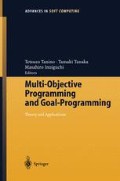Abstract
This paper provides a commentary and some analysis on recent advances in the field of distance metric optimisation, with particular reference to the place of distance metric optimisation within the overall disciplines of operational research and soft computing. The trend of integration and combination with other techniques is examined, with particular reference to the analytical hierarchy method, meta-heuristic methods, and data mining. Finally, some further thoughts on good modelling practice for distance metric optimisation models are offered.
Access this chapter
Tax calculation will be finalised at checkout
Purchases are for personal use only
Preview
Unable to display preview. Download preview PDF.
References
Baykasoglu A (2001) Goal programming using multiple objective tabu search, Journal Of The Operational Research Society, 52 (12), 1359–1369
Bryson. N (1995) A goal programming method for generating priority vectors, Journal of the Operational Research Society, 46 (5), 641–648.
Charnes A, Cooper WW, Ferguson R (1955) Optimal estimation of executive compensation by linear programming, Management Science, 1, 138–151.
Cooper WW, Lelas V, Sueyoshi, T (1997) Goal programming models and their duality relations for use in evaluating security portfolio and regression relations, European Journal of Operational Research, 98, 431–443.
Despotis DK (1996) Fractional minmax goal programming: A unified approach to priority estimation and preference analysis in MCDM, Journal Of The Operational Research Society, 47 (8): 989–999.
Ganjavi 0, Aouni B, Wang Z (2002) Technical note on balanced solutions in goal programming, compromise programming and reference point method, Journal Of The Operational Research Society, 53 (8): 927–929
Gass SI (1987) A process for determining priorities and weights for large scale goal programmes, Journal of the Operational Research Society, 37, 779–785.
Goldberg DE (1989) Genetic algorithms in search, optimization, and machine learning, Addison Wesley Longman, Reading, MA. Pages 185–197.
Ignizio JP (1982) Linear programming in single and multiple objective systems, Prentice Hall, Englewood Cliffs, NJ.
Islam R, Biswal MP, Alam SS (1997) Preference programming and inconsistent interval judgments, European Journal Of Operational Research, 97 (1): 53–62.
Jones DF(1995) The design and development of an intelligent goal programming system, Ph.D.Thesis,University of Portsmouth, UK.
Jones DF, Tamiz M (2002) Goal programming in the period 1990–2000, in Multiple criteria optimization state of the art annotated Bibliographic surveys, M. Erghott X. Gandibleux (eds.) Kluwver.
Jones DF., SK. Mirrazavi, and Tamiz M(2002) Multi-Objective meta-heuristics: an overview of the current state-of-the art, European Journal of Operational Research, 137, 1–9.
Michalewicz Z (1996) Genetic Algorithms + Data Structures = Evolution Structures, Springer-Verlag, Berlin, pages 80–93.
SK Mirrazavi, DF Jones, and M. Tamiz (2003) MultiGen: an integrated multiple-objective solution system, to appear in Decision Support Systems.
Ogryczak W (2001) Comments on Romero C, Tamiz M and Jones DF (1998). Goal programming, compromise programming and reference point method formulations: Linkages and utility interpretations, Journal Of The Operational Research Society, 52 (8): 960–962.
Romero C (2001) Extended lexicographic goal programming: a unifying approach, Omega-International Journal Of Management Science, 29 (1): 63–71.
Romero C, Tamiz M, Jones DF (1998) Goal programming, compromise programming and reference point method formulations: linkages and utility interpretations, Journal Of The Operational Research Society, 49 (9): 986–991.
T.L. Saaty (1977) A Scaling Method for Priorities in Hierarchical Structures, Journal of Mathematical Psychology, 15 (3), 234–281.
Stain A (1997) Nontraditional approaches to statistical classification: Some perspectives on lv norm methods’, Annals of Operations Research, 74, 1–36.
Sueyoshi, T, Sekitani K (1998) Mathematical properties of least absolute value estimation with serial correlation, Asia-Pacific Journal of Operational Research, 15, 75–92.
Tamiz, M, Jones, DF(1996) Goal Programming and Pareto Efficiency, Journal of Information and Optimization Sciences, 17, 291–307.
Tamiz, M and Jones DF (1997) An example of good modelling practice in goal programming: Means for overcoming incommensurability, Lecture notes in Economics and Mathematical Systems, R. Caballero, F. Ruiz(Eds), Springer, 455, 29–37.
Uria MVR, Caballero R, Ruiz F, Romero C (2002) Meta-goal programming, European Journal Of Operational Research, 136 (2): 422–429.
Yu PL (1973) A class of solutions for group decision problems, Management Science, 19, 936–946.
Author information
Authors and Affiliations
Rights and permissions
Copyright information
© 2003 Springer-Verlag Berlin Heidelberg
About this paper
Cite this paper
Jones, D.F., Tamiz, M. (2003). Analysis of Trends in Distance Metric Optimisation Modelling for Operational Research and Soft Computing. In: Multi-Objective Programming and Goal Programming. Advances in Soft Computing, vol 21. Springer, Berlin, Heidelberg. https://doi.org/10.1007/978-3-540-36510-5_2
Download citation
DOI: https://doi.org/10.1007/978-3-540-36510-5_2
Publisher Name: Springer, Berlin, Heidelberg
Print ISBN: 978-3-540-00653-4
Online ISBN: 978-3-540-36510-5
eBook Packages: Springer Book Archive

